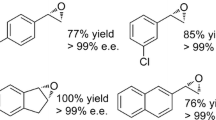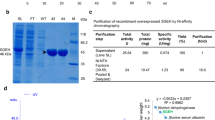Abstract
Objectives
To prepare (R)-phenyl-1,2-ethanediol ((R)-PED) with high enantiomeric excess (ee p) and yield from racemic styrene oxide (rac-SO) at high concentration by bi-enzymatic catalysis.
Results
The bi-enzymatic catalysis was designed for enantioconvergent hydrolysis of rac-SO by a pair of novel epoxide hydrolases (EHs), a Vigna radiata EH3 (VrEH3) and a variant (AuEH2A250I) of Aspergillus usamii EH2. The simultaneous addition mode of VrEH3 and AuEH2A250I, exhibiting the highest average turnover frequency (aTOF) of 0.12 g h−1 g−1, was selected, by which rac-SO (10 mM) was converted into (R)-PED with 92.6% ee p and 96.3% yield. Under the optimized reaction conditions: dry weight ratio 14:1 of VrEH3-expressing E. coli/vreh3 to AuEH2A250I-expressing E. coli/Aueh2 A250I and reaction at 20 °C, rac-SO (10 mM) was completely hydrolyzed in 2.3 h, affording (R)-PED with 98% ee p. At the weight ratio 0.8:1 of rac-SO to two mixed dry cells, (R)-PED with 97.4% ee p and 98.7% yield was produced from 200 mM (24 mg/ml) rac-SO in 10.5 h.
Conclusions
Enantioconvergent hydrolysis of rac-SO at high concentration catalyzed by both VrEH3 and AuEH2A250I is an effective method for preparing (R)-PED with high ee p and yield.




Similar content being viewed by others
References
Bala N, Chimni SS (2010) Recent developments in the asymmetric hydrolytic ring opening of epoxides catalysed by microbial epoxide hydrolase. Tetrahedron Asymmetry 21:2879–2898
Baldascini H, Ganzeveld KJ, Janssen DB, Beenackers AACM (2001) Effect of mass transfer limitations on the enzymatic kinetic resolution of epoxides in a two-liquid-phase system. Biotechnol Bioeng 73:44–54
Cao L, Lee J, Chen W, Wood TK (2006) Enantioconvergent production of (R)-1-phenyl-1,2-ethanediol from styrene oxide by combining the Solanum tuberosum and an evolved Agrobacterium radiobacter AD1 epoxide hydrolases. Biotechnol Bioeng 94:522–529
Choi SH, Kim HS, Lee EY (2009) Comparative homology modeling-inspired protein engineering for improvement of catalytic activity of Mugil cephalus epoxide hydrolase. Biotechnol Lett 31:1617–1624
Deregnaucourt J, Archelas A, Barbirato F, Paris JM, Furstoss R (2007) Enzymatic transformations 63. High-concentration two liquid-liquid phase Aspergillus niger epoxide hydrolase-catalysed resolution: application to trifluoromethyl-substituted aromatic epoxides. Adv Synth Catal 349:1405–1417
Hu D (2017) Gene cloning, molecular modification of an epoxide hydrolase from Aspergillus usamii and its application in synthesis of chiral compounds. Dissertation, Jiangnan University, Wuxi, China
Hu D, Wang R, Shi XL, Ye HH, Wu Q, Wu MC, Chu JJ (2016) Kinetic resolution of racemic styrene oxide at a high concentration by recombinant Aspergillus usamii epoxide hydrolase in an n-hexanol/buffer biphasic system. J Biotechnol 236:152–158
Hwang S, Choi CY, Lee EY (2008) One-pot biotransformation of racemic styrene oxide into (R)-1,2-phenylethandiol by two recombinant microbial epoxide hydrolases. Biotechnol Bioproc Eng 13:453–457
Kim HS, Lee OK, Hwang S, Kim BJ, Lee EY (2008) Biosynthesis of (R)-phenyl-1,2-ethanediol from racemic styrene oxide by using bacterial and marine fish epoxide hydrolases. Biotechnol Lett 30:127–133
Kotik M, Stepanek V, Grulich M, Kyslik P, Archelas A (2010) Access to enantiopure aromatic epoxides and diols using epoxide hydrolases derived from total biofilter DNA. J Mol Catal B Enzym 65:41–48
Kotik M, Archelas A, Wohlgemuth R (2012) Epoxide hydrolases and their application in organic synthesis. Curr Org Chem 16:451–482
Lee EY (2008) Epoxide hydrolase-mediated enantioconvergent bioconversions to prepare chiral epoxides and alcohols. Biotechnol Lett 30:1509–1514
Lee EY, Yoo SS, Kim HS, Lee SJ, Oh YK, Park S (2004) Production of (S)-styrene oxide by recombinant Pichia pastoris containing epoxide hydrolase from Rhodotorula glutinis. Enzyme Microb Technol 35:624–631
Min JY, Lee EY (2012) Biosynthesis of (R)-1,2-phenylethanediol and (R)-4-chloro-1,2-phenylethanediol by using two recombinant cells expressing enantiocomplementary epoxide hydrolases. J Ind Eng Chem 18:160–164
Pedragosa-Moreau S, Archelas A, Furtoss R (1993) Microbiological transformations. 28. Enaniocomplementary epoxide hydrolyses as a preparative access to both enantiomers of styrene oxide. J Org Chem 58:5533–5536
Wu K, Wang HL, Sun HH, Wei DZ (2015) Efficient kinetic resolution of phenyl glycidyl ether by a novel epoxide hydrolase from Tsukamurella paurometabola. Appl Microbiol Biotechnol 99:9511–9521
Yao (2016) Cloning and expression of an epoxide hydrolase gene from Vigna radiate and research on its hydrolysis properties. Dissertation, Jiangnan University, Wuxi, China
Ye HH, Hu D, Shi XL, Wu MC, Deng C, Li JF (2016) Directed modification of a novel epoxide hydrolase from Phaseolus vulgaris to improve its enantioconvergence towards styrene epoxides. Catal Commun 87:32–35
Zhu QQ, He WH, Kong XD, Fan LQ, Zhao J, Li SX, Xu JH (2014) Heterologous overexpression of Vigna radiata epoxide hydrolase in Escherichia coli and its catalytic performance in enantioconvergent hydrolysis of p-nitrostyrene oxide into (R)-p-nitrophenyl glycol. Appl Microbiol Biotechnol 98:207–218
Acknowledgements
This work was financially supported by the National Nature Science Foundation of China (21 676 117). The authors are greatful to Prof. Xianzhang Wu (School of Biotechnology, Jiangnan University) for providing technical assistance.
Supplementary information
Supplementary methods—the expression and activity assay of VrEH3 and AuEH2A250I.
Author information
Authors and Affiliations
Corresponding author
Electronic supplementary material
Below is the link to the electronic supplementary material.
Rights and permissions
About this article
Cite this article
Wang, R., Hu, D., Zong, X. et al. Enantioconvergent hydrolysis of racemic styrene oxide at high concentration by a pair of novel epoxide hydrolases into (R)-phenyl-1,2-ethanediol. Biotechnol Lett 39, 1917–1923 (2017). https://doi.org/10.1007/s10529-017-2433-z
Received:
Accepted:
Published:
Issue Date:
DOI: https://doi.org/10.1007/s10529-017-2433-z




